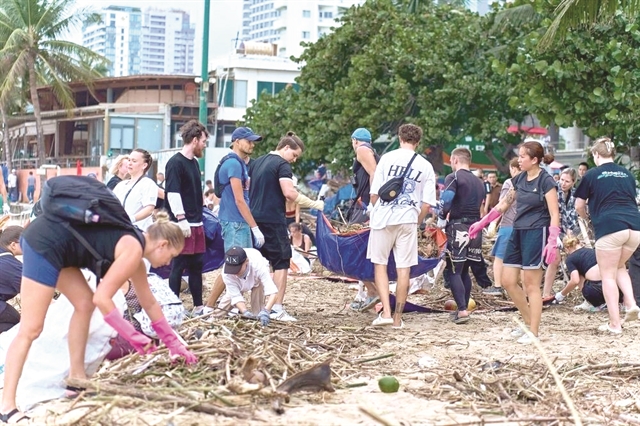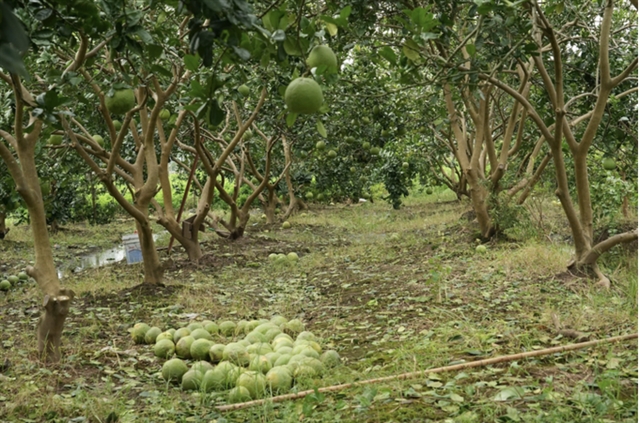 Opinion
Opinion


|
| Grapefruits which fell to the ground during the storm, which could lead to fruit shortages for the Lunar New Year festival. Photo nongnghiep.vn |
Typhoon Yagi caused severe damage to orchards, which could potentially impact supply for the upcoming Tết (Lunar New Year). Việt Nam News reporter Tố Như talked with Nguyễn Như Cường, director of the Department of Crop Production, about the issue.
The typhoon has passed, but its aftermath is severe. Some regions may take a long time to recover. From the perspective of growers, what solutions does the department have to immediately help farmers restore production?
After the typhoon, the crop sector faced two major problems.
First, about 312,000ha of crops had been flooded or flattened, with an estimated 100,000ha completely lost.
Over 200,000ha of rice were submerged, causing damage of approximately VNĐ3 trillion (US$125 million).
An additional 50,612ha of vegetables were inundated and 38,104ha of fruit trees were damaged, causing losses of around VNĐ1.25 trillion (US$52 million).
These are initial estimated losses, and local authorities are still conducting surveys and reviews to obtain more accurate figures.
The second issue was flash flooding, which severely affected cultivated land, making it impossible to grow crops in certain areas for the foreseeable future.
Some regions will need to change their farming practices, such as switching from rice to fruit trees.
The Department of Crop Production has submitted proposals to the Ministry of Agriculture and Rural Development to issue guidelines on how to recover crop production after the typhoon for different crop categories.
However, I want to emphasise that while we focus on recovery efforts, we must also assess and categorise the extent of crop damage in order to devise specific solutions.
For areas that can be restored, recovery efforts will proceed. For those that cannot be restored, we will need to clean up, sanitise the fields and drain water in preparation for early winter crop planting.
For vegetables, I urge localities to quickly inspect and drain water, clean the fields and prepare seeds and soil for areas that cannot recover. Prioritise planting leafy greens, short-term crops and water-loving vegetables, to supply the market during the transition period.
This will not only meet market demand but also help ensure farmers' livelihoods.
This approach also applies to fruit trees.
Additionally, in September, the ministry will organise a Winter Crop Conference to promote production recovery and expand winter crop areas. We aim to balance production to meet market demand.
With the typhoon causing such extensive damage to winter crops, do we have enough vegetables and fruits for the Lunar New Year?
The typhoon struck before we began planting winter crops. The storm's damage primarily affected high-altitude vegetable-growing regions.
As I mentioned earlier, we need to urgently clean up fields and prepare materials, fertilisers and seeds to restore production after the typhoon.
In response to market demand and specific conditions, we will initially plant short-term crops and leafy vegetables. These crops can be harvested within twenty-five to thirty days.
At the same time, we will continue preparing and ensuring an adequate seed structure to meet vegetable demand at the end of the year, particularly during the Tết season.
As for fruit trees, the biggest losses due to the typhoon in the northern region were for citrus trees and bananas. Grapefruit and bananas are two fruits with high demand during the Lunar New Year, as every family needs them for their five-fruit tray offerings.
However, it is important to recognise that planting bananas or restoring grapefruit orchards at this time will not yield fruits in time for Tết.
Currently, the regions where these two crops were less affected by the storm are concentrating all efforts on recovery to produce sufficient yields to offset the losses in hard-hit areas.
Additionally, given current transport conditions, there may be some shortages of certain items and prices might rise, but there will not be a drastic spike.
What is the most important factor for the crop sector at the moment?
The most crucial task for crop production is to restore production after the storms.
The availability of seeds and essential inputs is vital. The department has already sent official letters to associations, industry bodies and businesses, urging them to offer support to farmers based on their own conditions.
We have also asked companies to commit to not increasing prices, especially for seeds.
In addition, we need resources for environmental management to aid production recovery. VNS